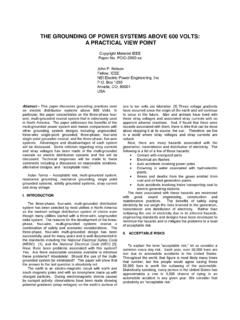Transcription of Health and Safety Fact Sheet: High Voltage (>1000 Volts ...
1 Health and Safety Fact Sheet: High Voltage (> 1000 Volts ) electrical Safety and injuries October 2009. Overview The purpose of this Fact Sheet is to raise awareness of the risks of high Voltage electrical shock, review how workers can protect themselves during high Voltage electrical work, and summarize how proper medical treatment can be provided in an expedient and effective way for any worker injured by this type of hazard. While this Fact Sheet has been provided for members of the Energy Recovery Council (ERC), all industries and personnel who might encounter the effects of a high Voltage electrical shock can benefit from the details of this Fact Sheet. Converting waste Into renewable electricity Why is there a concern about high Voltage electrical shock? The Bureau of Labor Statistics data from 2001 through 2007 reports an average of approximately 250 deaths per year occurring from electric injury in the United States.
2 Deaths related to exposure to electric current consistently make up around 4% of all occupational fatalities (2). In addition to fatalities, major high- Voltage electrical trauma can produce devastating physical injuries . Repeated removal of tissue, amputations, and extensive rehabilitation are common in high Voltage electrical injuries . It is not unusual for treatment to require tissue removal over several days, and frequently the damage becomes significant enough to warrant amputation. Limb amputation rates for victims who experience direct electrical contact can be as high as 75%, and most victims who survive high- Voltage electrical shock are left permanently disabled (12). Page 1/5. Through the OSHA and ERC Alliance, ERC developed this Fact Sheet for informational purposes only. It does not necessarily reflect the official views of OSHA or the Department of Labor.
3 Oct. 2009. electrical injuries - How does your body get damaged? In non-technical terms, damage from high Voltage electrical fields is caused primarily by heating and to a lesser extent the breakdown of cell membranes. In most cases, heat damage occurs instantly at the point of contact, but injury to deeper tissues requires several seconds. The tissues in our body, with the exception of the skin, are reasonably good conductors. If a person comes into contact with a high- Voltage power source, the outer layer of the skin is usually destroyed by heat within milliseconds. Once the outer layer of the skin is destroyed, large currents are able to pass through and produce tissue damage, especially to skeletal muscle and nerve. In addition to tissue damage, an arc blast can cause other types of injuries from the physical force of impacts including falls, broken bones, and concussions.
4 In addition, other non-physical issues may affect employees with electrical injuries . Examples of these include problems with the speed of mental processing, attention, concentration, memory, and post traumatic stress disorders. These conditions have the potential to be as life-changing as a major physical injury (3). What Are Burn Treatment Concerns for High Voltage electrical Shock? For voltages above 1000V, electrical burn wounds possess special clinical characteristics. Below that level, cardiac fibrillation is the major risk while skin lesions are typically minor. Above 1000 V, there is a risk of wounds which can lead to amputation. The most challenging aspect of initial treatment is that the tissue in the electric current path, unless there has been significant heating, may appear very normal. Typically, it is at least 1 to 3 days before the true extent of damage can be recognized.
5 Furthermore, healthy skin and fat often conceal injured muscles, nerves, and bone. Thus, it is very difficult to accurately diagnose and localize tissue damage scattered throughout the current path before irreversible cell damage has occurred. Therefore, even when the injury doesn't involve any visible tissue damage, electrical shock survivors may be left with significant consequences. electrical burns represent only 4 % of all burns. So, research and specific expertise for their treatment has been slow in developing. Presently, there is no method of estimating the damage done to the tissue by heat which has already dissipated, sometimes leaving the tissue with a misleading appearance of Health . It is very important that employees and employers understand that even with no visible burn, survivors may be faced with long-term muscular pain and discomfort, fatigue, inadequate balance and coordination or even limb amputation.
6 Though we often refer to exit and entry wounds, with alternating current there is no such thing as current entering or leaving. Instead, one contact point is better (lower Page 2/5. Through the OSHA and ERC Alliance, ERC developed this Fact Sheet for informational purposes only. It does not necessarily reflect the official views of OSHA or the Department of Labor. Oct. 2009. impedance) than the other. Sometimes, the skin damage visible at the hospital may be very small while internal damage extends farther. For this reason, it is very important for workers to get to a specialized burn center or to tell the 911 operator that this is a 1000 V. shock exposure that requires the attention of a burn center specialist. Treatment is complicated by progressive tissue death (necrosis) (10, 11) and the need for multiple surgical interventions.
7 Surgeons have difficulty identifying the living versus dead tissue. The complicated pattern of electrical burns inside the body is difficult to map. (6, 9). What do workers need to know? Ask what controls are in place and what is required. Engage in high Voltage electrical work only if you are trained and authorized to do so. Follow plant procedures when working on any electrical equipment, particularly breakers, motor control centers (MCC rooms) and transformers. Take the necessary precautions appropriate for the hazard class you are working with. Wear the personal protective equipment associated with the Voltage you are handling. Maintain current first aid and cardiopulmonary resuscitation training (CPR), including the use of an automated external defibrillator (AED) where an AED. program is in place. Every effort should be made to work on DEENERGIZED.
8 Circuits and equipment, only, or have CPR- and AED-trained persons available. Such a requirement means that two workers need to be present when circuits and equipment are not deenergized. As with any hazard in the workplace, the hierarchy of control for electrical exposure proceeds from engineering, work practice controls, and then to the least preferred method of PPE. Work practice controls such as worker placement, training programs and work procedures will continue to be a huge effort in the industry. As we learn more and more about electrical risks, we will adjust these programs to meet the needs of a changing industry. Page 3/5. Through the OSHA and ERC Alliance, ERC developed this Fact Sheet for informational purposes only. It does not necessarily reflect the official views of OSHA or the Department of Labor. Oct.
9 2009. If a worker has an exposure to 1000 Volts or greater, initiate an emergency response action. Be specific to the 911 operator that the injury is from contact with over 1000 V and that immediate evaluation by a burn center is needed. Accidents can occur while changing fuses under power, bridging electrical terminals with a metal watch band, testing 600 V voltages with an instrument in the wrong setting or in the creation of arc burns in welding. If the worker is exposed to contact with parts energized at more than 600. Volts , a second person should be present while the work is being performed. This additional person is available to assist in the event that the worker receives an electric shock. Lastly, selecting PPE is always a challenge. While rubber glove requirements and use have been around a long time, the evolution of electrical flame retardant clothing is relatively new and still evolving.
10 While NFPA 70E gives great guidance, it too is evolving as more information becomes available. One only needs to look at the changes in the guidance document over the years and most recently the 2004 vs. 2009 revisions. In the past, NFPA 70E had a hazard/risk category for tasks performed on energized equipment rated 1000V. and up (that category is now limited through 38kV). While most employees in the industry are not exposed to these higher levels for day to day operations, there is the occasional exposure in our switchyards that will now need to be re-evaluated to determine adequacy of PPE for switching, inspection, grounds keeping and other activities that take place here. The PPE itself continues to evolve with manufacturers providing lighter and more flexible clothing as the need has grown, and so what we used last year may be different from next year because of technological change.






